HI6028 Taxation Law: Capital Gains Tax and Income Tax Assessment
VerifiedAdded on 2023/03/30
|9
|2108
|132
Report
AI Summary
This report delves into various aspects of Australian Taxation Law, primarily focusing on capital gains tax (CGT) and income tax implications. It addresses scenarios involving the sale of antique paintings, historical sculptures, and jewelry, analyzing whether these items qualify as CGT assets under the Income Tax Assessment Act 1997. The report also examines the tax implications of income received from writing a book, differentiating between income derived from personal exertion and income from hobbies. Furthermore, it discusses the taxability of loan repayments, particularly when additional amounts are paid beyond the principal. The analysis incorporates relevant sections of the Income Tax Assessment Act 1997 and references key case laws to provide a comprehensive understanding of the legal principles involved. Desklib offers a wide range of similar solved assignments and study resources for students.
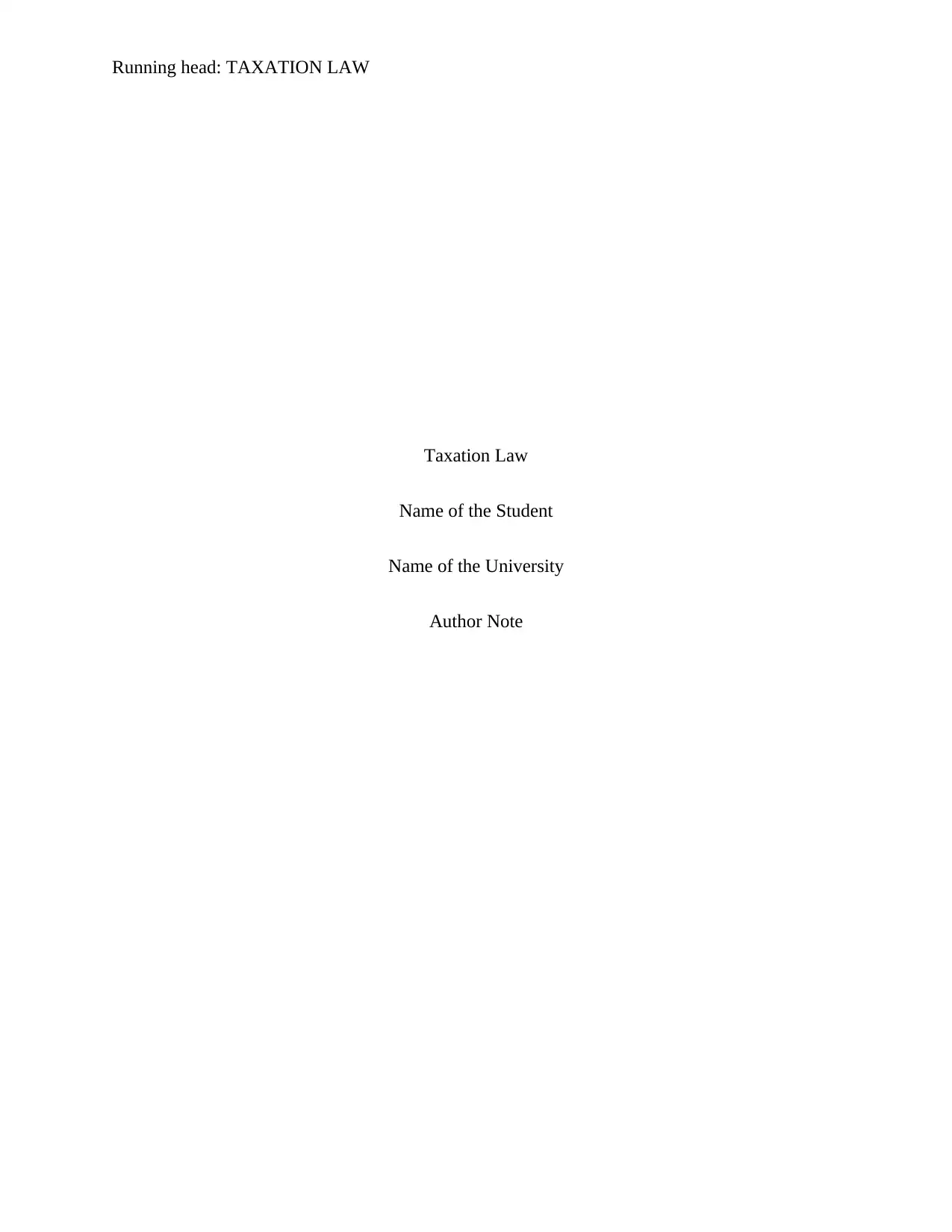
Running head: TAXATION LAW
Taxation Law
Name of the Student
Name of the University
Author Note
Taxation Law
Name of the Student
Name of the University
Author Note
Paraphrase This Document
Need a fresh take? Get an instant paraphrase of this document with our AI Paraphraser
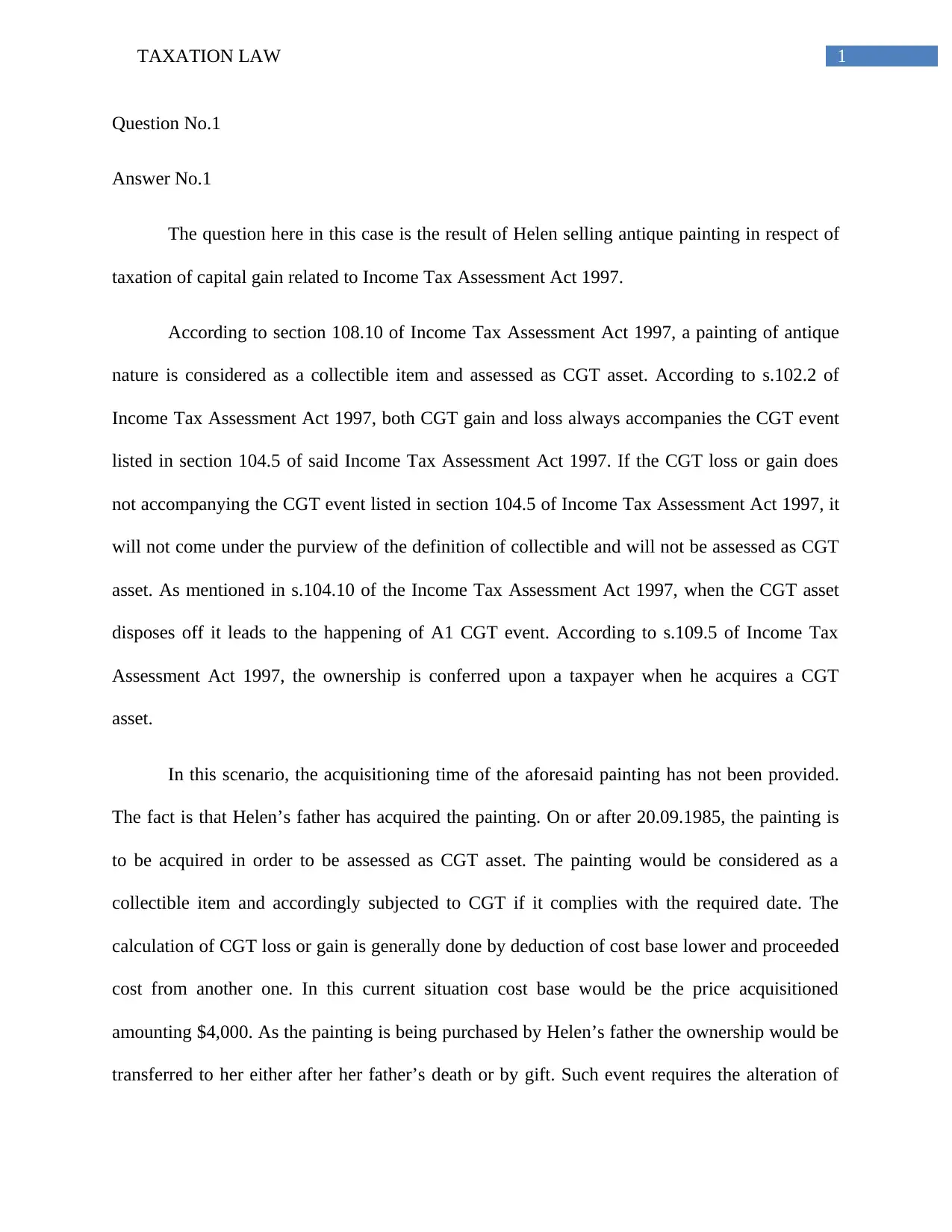
1TAXATION LAW
Question No.1
Answer No.1
The question here in this case is the result of Helen selling antique painting in respect of
taxation of capital gain related to Income Tax Assessment Act 1997.
According to section 108.10 of Income Tax Assessment Act 1997, a painting of antique
nature is considered as a collectible item and assessed as CGT asset. According to s.102.2 of
Income Tax Assessment Act 1997, both CGT gain and loss always accompanies the CGT event
listed in section 104.5 of said Income Tax Assessment Act 1997. If the CGT loss or gain does
not accompanying the CGT event listed in section 104.5 of Income Tax Assessment Act 1997, it
will not come under the purview of the definition of collectible and will not be assessed as CGT
asset. As mentioned in s.104.10 of the Income Tax Assessment Act 1997, when the CGT asset
disposes off it leads to the happening of A1 CGT event. According to s.109.5 of Income Tax
Assessment Act 1997, the ownership is conferred upon a taxpayer when he acquires a CGT
asset.
In this scenario, the acquisitioning time of the aforesaid painting has not been provided.
The fact is that Helen’s father has acquired the painting. On or after 20.09.1985, the painting is
to be acquired in order to be assessed as CGT asset. The painting would be considered as a
collectible item and accordingly subjected to CGT if it complies with the required date. The
calculation of CGT loss or gain is generally done by deduction of cost base lower and proceeded
cost from another one. In this current situation cost base would be the price acquisitioned
amounting $4,000. As the painting is being purchased by Helen’s father the ownership would be
transferred to her either after her father’s death or by gift. Such event requires the alteration of
Question No.1
Answer No.1
The question here in this case is the result of Helen selling antique painting in respect of
taxation of capital gain related to Income Tax Assessment Act 1997.
According to section 108.10 of Income Tax Assessment Act 1997, a painting of antique
nature is considered as a collectible item and assessed as CGT asset. According to s.102.2 of
Income Tax Assessment Act 1997, both CGT gain and loss always accompanies the CGT event
listed in section 104.5 of said Income Tax Assessment Act 1997. If the CGT loss or gain does
not accompanying the CGT event listed in section 104.5 of Income Tax Assessment Act 1997, it
will not come under the purview of the definition of collectible and will not be assessed as CGT
asset. As mentioned in s.104.10 of the Income Tax Assessment Act 1997, when the CGT asset
disposes off it leads to the happening of A1 CGT event. According to s.109.5 of Income Tax
Assessment Act 1997, the ownership is conferred upon a taxpayer when he acquires a CGT
asset.
In this scenario, the acquisitioning time of the aforesaid painting has not been provided.
The fact is that Helen’s father has acquired the painting. On or after 20.09.1985, the painting is
to be acquired in order to be assessed as CGT asset. The painting would be considered as a
collectible item and accordingly subjected to CGT if it complies with the required date. The
calculation of CGT loss or gain is generally done by deduction of cost base lower and proceeded
cost from another one. In this current situation cost base would be the price acquisitioned
amounting $4,000. As the painting is being purchased by Helen’s father the ownership would be
transferred to her either after her father’s death or by gift. Such event requires the alteration of
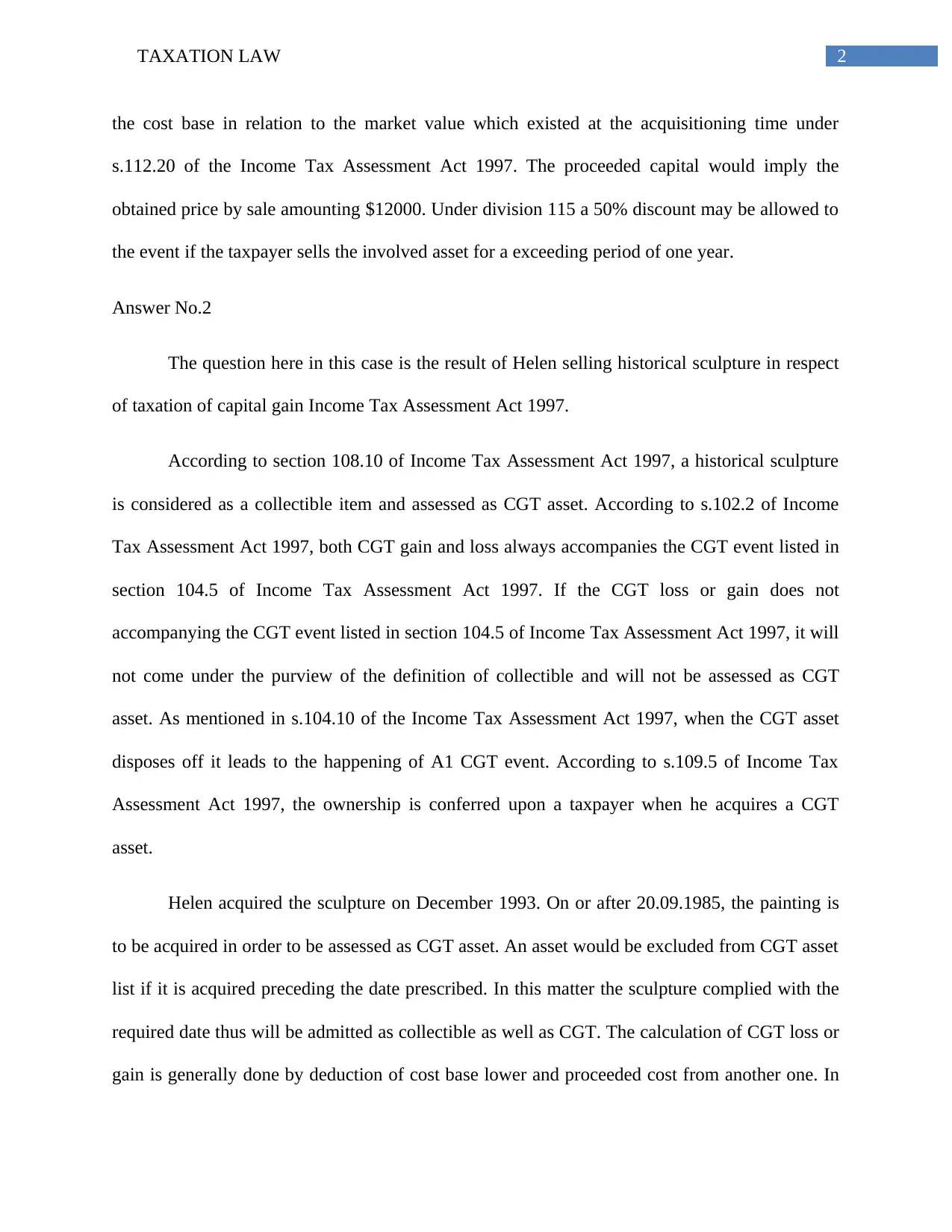
2TAXATION LAW
the cost base in relation to the market value which existed at the acquisitioning time under
s.112.20 of the Income Tax Assessment Act 1997. The proceeded capital would imply the
obtained price by sale amounting $12000. Under division 115 a 50% discount may be allowed to
the event if the taxpayer sells the involved asset for a exceeding period of one year.
Answer No.2
The question here in this case is the result of Helen selling historical sculpture in respect
of taxation of capital gain Income Tax Assessment Act 1997.
According to section 108.10 of Income Tax Assessment Act 1997, a historical sculpture
is considered as a collectible item and assessed as CGT asset. According to s.102.2 of Income
Tax Assessment Act 1997, both CGT gain and loss always accompanies the CGT event listed in
section 104.5 of Income Tax Assessment Act 1997. If the CGT loss or gain does not
accompanying the CGT event listed in section 104.5 of Income Tax Assessment Act 1997, it will
not come under the purview of the definition of collectible and will not be assessed as CGT
asset. As mentioned in s.104.10 of the Income Tax Assessment Act 1997, when the CGT asset
disposes off it leads to the happening of A1 CGT event. According to s.109.5 of Income Tax
Assessment Act 1997, the ownership is conferred upon a taxpayer when he acquires a CGT
asset.
Helen acquired the sculpture on December 1993. On or after 20.09.1985, the painting is
to be acquired in order to be assessed as CGT asset. An asset would be excluded from CGT asset
list if it is acquired preceding the date prescribed. In this matter the sculpture complied with the
required date thus will be admitted as collectible as well as CGT. The calculation of CGT loss or
gain is generally done by deduction of cost base lower and proceeded cost from another one. In
the cost base in relation to the market value which existed at the acquisitioning time under
s.112.20 of the Income Tax Assessment Act 1997. The proceeded capital would imply the
obtained price by sale amounting $12000. Under division 115 a 50% discount may be allowed to
the event if the taxpayer sells the involved asset for a exceeding period of one year.
Answer No.2
The question here in this case is the result of Helen selling historical sculpture in respect
of taxation of capital gain Income Tax Assessment Act 1997.
According to section 108.10 of Income Tax Assessment Act 1997, a historical sculpture
is considered as a collectible item and assessed as CGT asset. According to s.102.2 of Income
Tax Assessment Act 1997, both CGT gain and loss always accompanies the CGT event listed in
section 104.5 of Income Tax Assessment Act 1997. If the CGT loss or gain does not
accompanying the CGT event listed in section 104.5 of Income Tax Assessment Act 1997, it will
not come under the purview of the definition of collectible and will not be assessed as CGT
asset. As mentioned in s.104.10 of the Income Tax Assessment Act 1997, when the CGT asset
disposes off it leads to the happening of A1 CGT event. According to s.109.5 of Income Tax
Assessment Act 1997, the ownership is conferred upon a taxpayer when he acquires a CGT
asset.
Helen acquired the sculpture on December 1993. On or after 20.09.1985, the painting is
to be acquired in order to be assessed as CGT asset. An asset would be excluded from CGT asset
list if it is acquired preceding the date prescribed. In this matter the sculpture complied with the
required date thus will be admitted as collectible as well as CGT. The calculation of CGT loss or
gain is generally done by deduction of cost base lower and proceeded cost from another one. In
⊘ This is a preview!⊘
Do you want full access?
Subscribe today to unlock all pages.

Trusted by 1+ million students worldwide
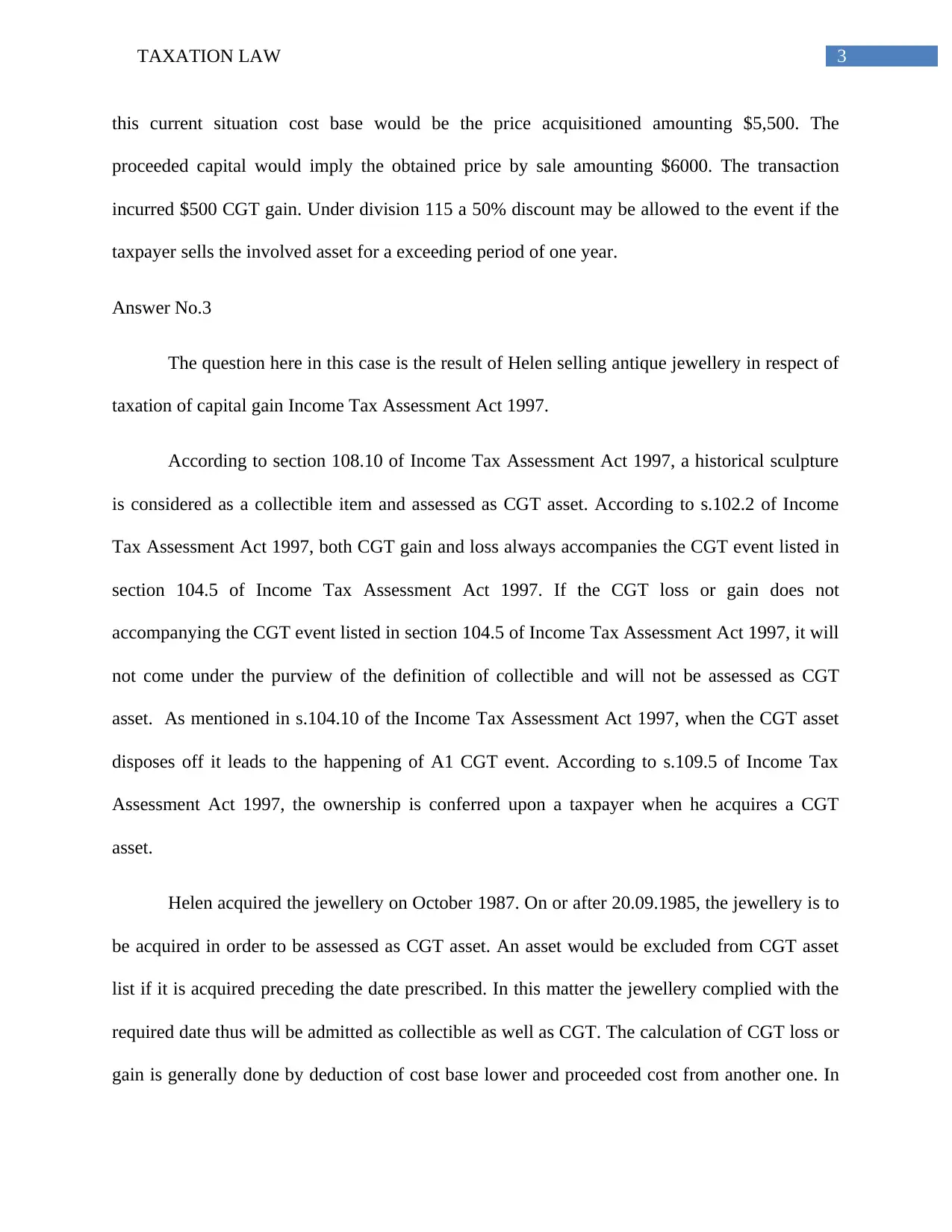
3TAXATION LAW
this current situation cost base would be the price acquisitioned amounting $5,500. The
proceeded capital would imply the obtained price by sale amounting $6000. The transaction
incurred $500 CGT gain. Under division 115 a 50% discount may be allowed to the event if the
taxpayer sells the involved asset for a exceeding period of one year.
Answer No.3
The question here in this case is the result of Helen selling antique jewellery in respect of
taxation of capital gain Income Tax Assessment Act 1997.
According to section 108.10 of Income Tax Assessment Act 1997, a historical sculpture
is considered as a collectible item and assessed as CGT asset. According to s.102.2 of Income
Tax Assessment Act 1997, both CGT gain and loss always accompanies the CGT event listed in
section 104.5 of Income Tax Assessment Act 1997. If the CGT loss or gain does not
accompanying the CGT event listed in section 104.5 of Income Tax Assessment Act 1997, it will
not come under the purview of the definition of collectible and will not be assessed as CGT
asset. As mentioned in s.104.10 of the Income Tax Assessment Act 1997, when the CGT asset
disposes off it leads to the happening of A1 CGT event. According to s.109.5 of Income Tax
Assessment Act 1997, the ownership is conferred upon a taxpayer when he acquires a CGT
asset.
Helen acquired the jewellery on October 1987. On or after 20.09.1985, the jewellery is to
be acquired in order to be assessed as CGT asset. An asset would be excluded from CGT asset
list if it is acquired preceding the date prescribed. In this matter the jewellery complied with the
required date thus will be admitted as collectible as well as CGT. The calculation of CGT loss or
gain is generally done by deduction of cost base lower and proceeded cost from another one. In
this current situation cost base would be the price acquisitioned amounting $5,500. The
proceeded capital would imply the obtained price by sale amounting $6000. The transaction
incurred $500 CGT gain. Under division 115 a 50% discount may be allowed to the event if the
taxpayer sells the involved asset for a exceeding period of one year.
Answer No.3
The question here in this case is the result of Helen selling antique jewellery in respect of
taxation of capital gain Income Tax Assessment Act 1997.
According to section 108.10 of Income Tax Assessment Act 1997, a historical sculpture
is considered as a collectible item and assessed as CGT asset. According to s.102.2 of Income
Tax Assessment Act 1997, both CGT gain and loss always accompanies the CGT event listed in
section 104.5 of Income Tax Assessment Act 1997. If the CGT loss or gain does not
accompanying the CGT event listed in section 104.5 of Income Tax Assessment Act 1997, it will
not come under the purview of the definition of collectible and will not be assessed as CGT
asset. As mentioned in s.104.10 of the Income Tax Assessment Act 1997, when the CGT asset
disposes off it leads to the happening of A1 CGT event. According to s.109.5 of Income Tax
Assessment Act 1997, the ownership is conferred upon a taxpayer when he acquires a CGT
asset.
Helen acquired the jewellery on October 1987. On or after 20.09.1985, the jewellery is to
be acquired in order to be assessed as CGT asset. An asset would be excluded from CGT asset
list if it is acquired preceding the date prescribed. In this matter the jewellery complied with the
required date thus will be admitted as collectible as well as CGT. The calculation of CGT loss or
gain is generally done by deduction of cost base lower and proceeded cost from another one. In
Paraphrase This Document
Need a fresh take? Get an instant paraphrase of this document with our AI Paraphraser
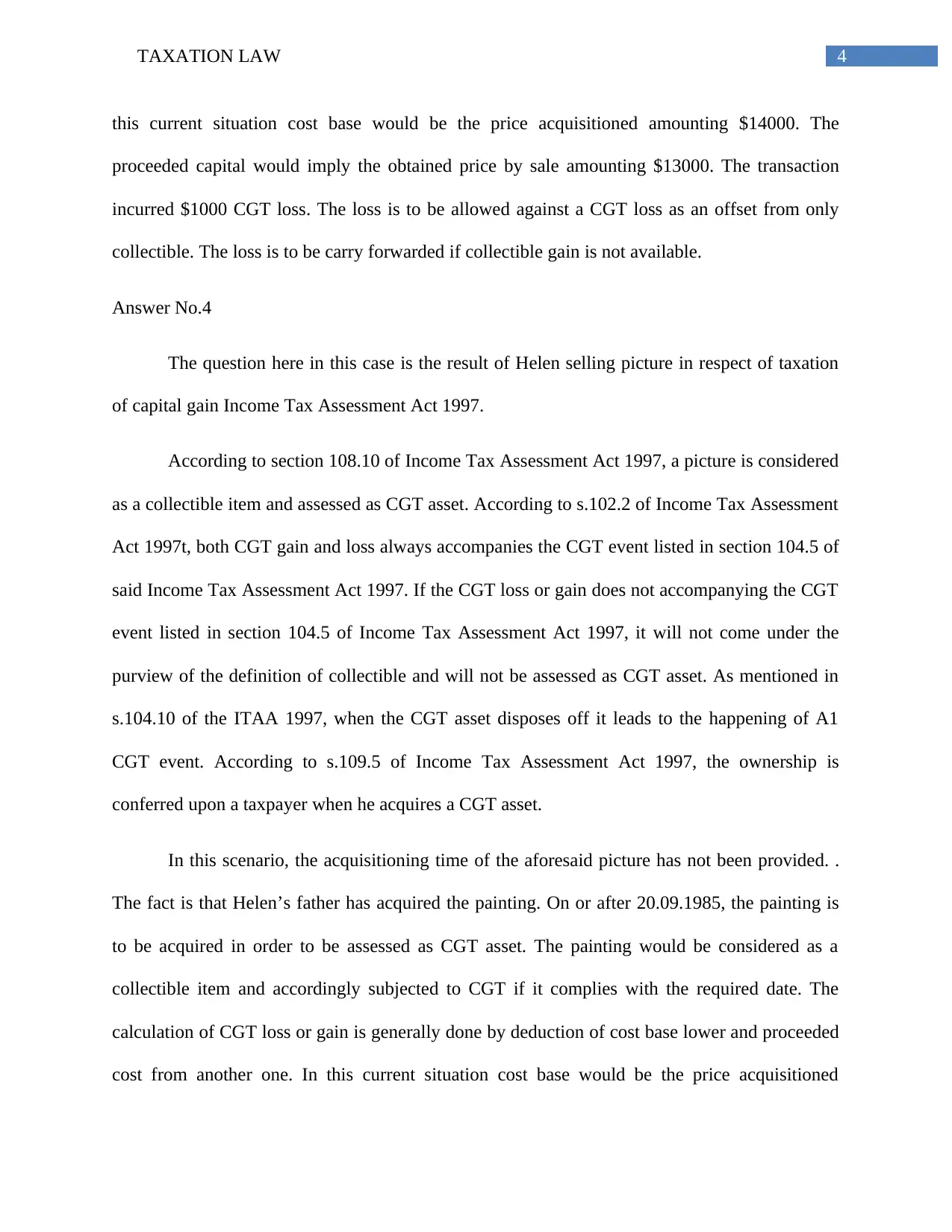
4TAXATION LAW
this current situation cost base would be the price acquisitioned amounting $14000. The
proceeded capital would imply the obtained price by sale amounting $13000. The transaction
incurred $1000 CGT loss. The loss is to be allowed against a CGT loss as an offset from only
collectible. The loss is to be carry forwarded if collectible gain is not available.
Answer No.4
The question here in this case is the result of Helen selling picture in respect of taxation
of capital gain Income Tax Assessment Act 1997.
According to section 108.10 of Income Tax Assessment Act 1997, a picture is considered
as a collectible item and assessed as CGT asset. According to s.102.2 of Income Tax Assessment
Act 1997t, both CGT gain and loss always accompanies the CGT event listed in section 104.5 of
said Income Tax Assessment Act 1997. If the CGT loss or gain does not accompanying the CGT
event listed in section 104.5 of Income Tax Assessment Act 1997, it will not come under the
purview of the definition of collectible and will not be assessed as CGT asset. As mentioned in
s.104.10 of the ITAA 1997, when the CGT asset disposes off it leads to the happening of A1
CGT event. According to s.109.5 of Income Tax Assessment Act 1997, the ownership is
conferred upon a taxpayer when he acquires a CGT asset.
In this scenario, the acquisitioning time of the aforesaid picture has not been provided. .
The fact is that Helen’s father has acquired the painting. On or after 20.09.1985, the painting is
to be acquired in order to be assessed as CGT asset. The painting would be considered as a
collectible item and accordingly subjected to CGT if it complies with the required date. The
calculation of CGT loss or gain is generally done by deduction of cost base lower and proceeded
cost from another one. In this current situation cost base would be the price acquisitioned
this current situation cost base would be the price acquisitioned amounting $14000. The
proceeded capital would imply the obtained price by sale amounting $13000. The transaction
incurred $1000 CGT loss. The loss is to be allowed against a CGT loss as an offset from only
collectible. The loss is to be carry forwarded if collectible gain is not available.
Answer No.4
The question here in this case is the result of Helen selling picture in respect of taxation
of capital gain Income Tax Assessment Act 1997.
According to section 108.10 of Income Tax Assessment Act 1997, a picture is considered
as a collectible item and assessed as CGT asset. According to s.102.2 of Income Tax Assessment
Act 1997t, both CGT gain and loss always accompanies the CGT event listed in section 104.5 of
said Income Tax Assessment Act 1997. If the CGT loss or gain does not accompanying the CGT
event listed in section 104.5 of Income Tax Assessment Act 1997, it will not come under the
purview of the definition of collectible and will not be assessed as CGT asset. As mentioned in
s.104.10 of the ITAA 1997, when the CGT asset disposes off it leads to the happening of A1
CGT event. According to s.109.5 of Income Tax Assessment Act 1997, the ownership is
conferred upon a taxpayer when he acquires a CGT asset.
In this scenario, the acquisitioning time of the aforesaid picture has not been provided. .
The fact is that Helen’s father has acquired the painting. On or after 20.09.1985, the painting is
to be acquired in order to be assessed as CGT asset. The painting would be considered as a
collectible item and accordingly subjected to CGT if it complies with the required date. The
calculation of CGT loss or gain is generally done by deduction of cost base lower and proceeded
cost from another one. In this current situation cost base would be the price acquisitioned
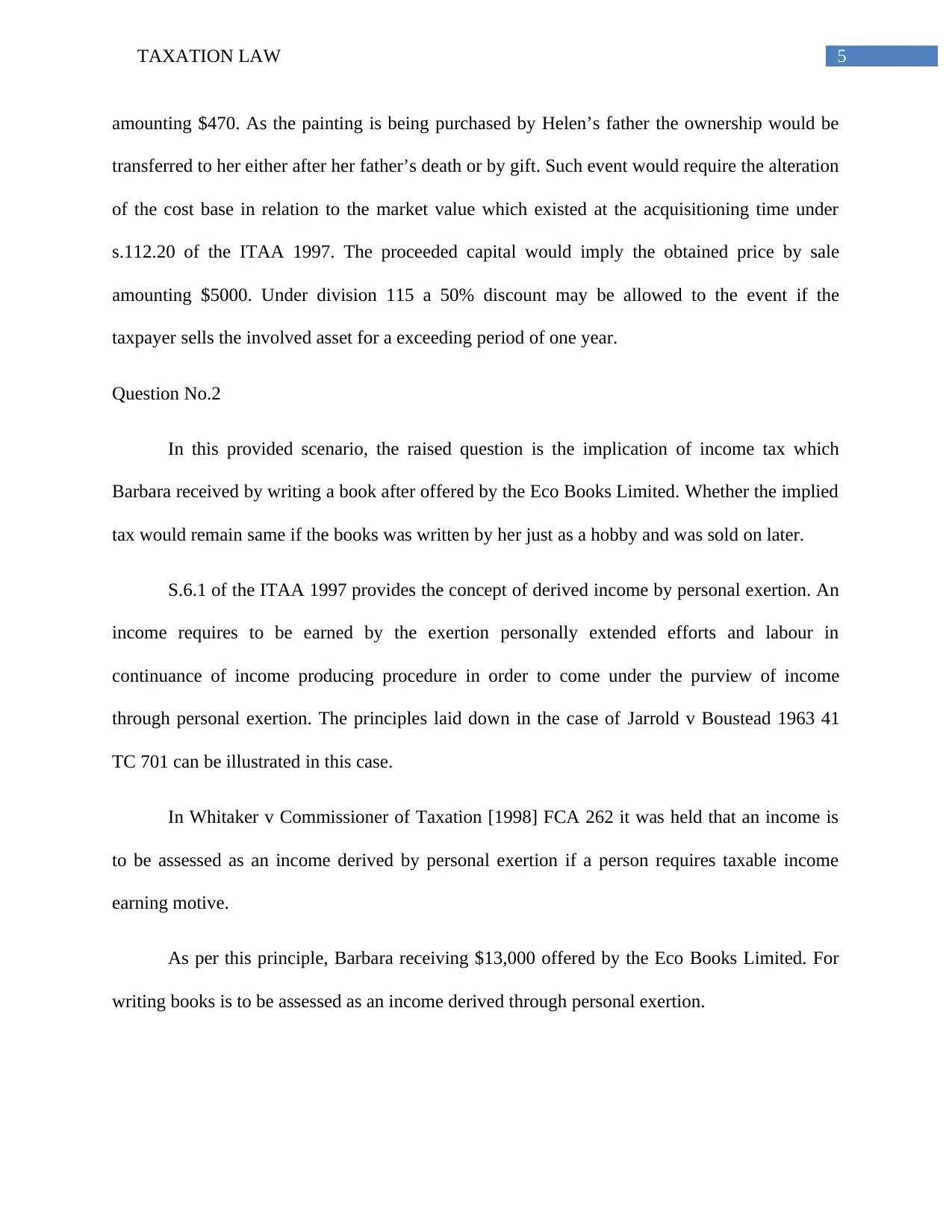
5TAXATION LAW
amounting $470. As the painting is being purchased by Helen’s father the ownership would be
transferred to her either after her father’s death or by gift. Such event would require the alteration
of the cost base in relation to the market value which existed at the acquisitioning time under
s.112.20 of the ITAA 1997. The proceeded capital would imply the obtained price by sale
amounting $5000. Under division 115 a 50% discount may be allowed to the event if the
taxpayer sells the involved asset for a exceeding period of one year.
Question No.2
In this provided scenario, the raised question is the implication of income tax which
Barbara received by writing a book after offered by the Eco Books Limited. Whether the implied
tax would remain same if the books was written by her just as a hobby and was sold on later.
S.6.1 of the ITAA 1997 provides the concept of derived income by personal exertion. An
income requires to be earned by the exertion personally extended efforts and labour in
continuance of income producing procedure in order to come under the purview of income
through personal exertion. The principles laid down in the case of Jarrold v Boustead 1963 41
TC 701 can be illustrated in this case.
In Whitaker v Commissioner of Taxation [1998] FCA 262 it was held that an income is
to be assessed as an income derived by personal exertion if a person requires taxable income
earning motive.
As per this principle, Barbara receiving $13,000 offered by the Eco Books Limited. For
writing books is to be assessed as an income derived through personal exertion.
amounting $470. As the painting is being purchased by Helen’s father the ownership would be
transferred to her either after her father’s death or by gift. Such event would require the alteration
of the cost base in relation to the market value which existed at the acquisitioning time under
s.112.20 of the ITAA 1997. The proceeded capital would imply the obtained price by sale
amounting $5000. Under division 115 a 50% discount may be allowed to the event if the
taxpayer sells the involved asset for a exceeding period of one year.
Question No.2
In this provided scenario, the raised question is the implication of income tax which
Barbara received by writing a book after offered by the Eco Books Limited. Whether the implied
tax would remain same if the books was written by her just as a hobby and was sold on later.
S.6.1 of the ITAA 1997 provides the concept of derived income by personal exertion. An
income requires to be earned by the exertion personally extended efforts and labour in
continuance of income producing procedure in order to come under the purview of income
through personal exertion. The principles laid down in the case of Jarrold v Boustead 1963 41
TC 701 can be illustrated in this case.
In Whitaker v Commissioner of Taxation [1998] FCA 262 it was held that an income is
to be assessed as an income derived by personal exertion if a person requires taxable income
earning motive.
As per this principle, Barbara receiving $13,000 offered by the Eco Books Limited. For
writing books is to be assessed as an income derived through personal exertion.
⊘ This is a preview!⊘
Do you want full access?
Subscribe today to unlock all pages.

Trusted by 1+ million students worldwide
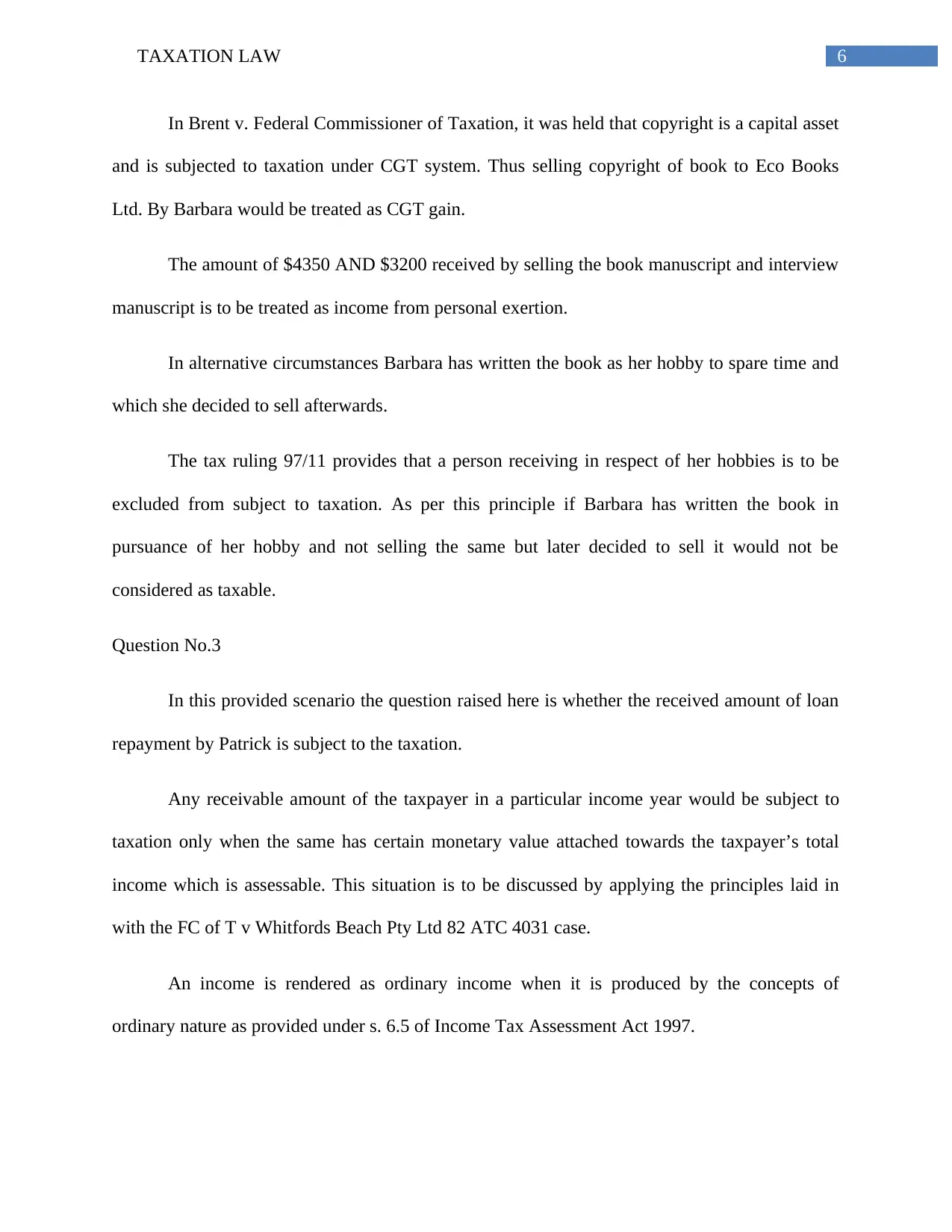
6TAXATION LAW
In Brent v. Federal Commissioner of Taxation, it was held that copyright is a capital asset
and is subjected to taxation under CGT system. Thus selling copyright of book to Eco Books
Ltd. By Barbara would be treated as CGT gain.
The amount of $4350 AND $3200 received by selling the book manuscript and interview
manuscript is to be treated as income from personal exertion.
In alternative circumstances Barbara has written the book as her hobby to spare time and
which she decided to sell afterwards.
The tax ruling 97/11 provides that a person receiving in respect of her hobbies is to be
excluded from subject to taxation. As per this principle if Barbara has written the book in
pursuance of her hobby and not selling the same but later decided to sell it would not be
considered as taxable.
Question No.3
In this provided scenario the question raised here is whether the received amount of loan
repayment by Patrick is subject to the taxation.
Any receivable amount of the taxpayer in a particular income year would be subject to
taxation only when the same has certain monetary value attached towards the taxpayer’s total
income which is assessable. This situation is to be discussed by applying the principles laid in
with the FC of T v Whitfords Beach Pty Ltd 82 ATC 4031 case.
An income is rendered as ordinary income when it is produced by the concepts of
ordinary nature as provided under s. 6.5 of Income Tax Assessment Act 1997.
In Brent v. Federal Commissioner of Taxation, it was held that copyright is a capital asset
and is subjected to taxation under CGT system. Thus selling copyright of book to Eco Books
Ltd. By Barbara would be treated as CGT gain.
The amount of $4350 AND $3200 received by selling the book manuscript and interview
manuscript is to be treated as income from personal exertion.
In alternative circumstances Barbara has written the book as her hobby to spare time and
which she decided to sell afterwards.
The tax ruling 97/11 provides that a person receiving in respect of her hobbies is to be
excluded from subject to taxation. As per this principle if Barbara has written the book in
pursuance of her hobby and not selling the same but later decided to sell it would not be
considered as taxable.
Question No.3
In this provided scenario the question raised here is whether the received amount of loan
repayment by Patrick is subject to the taxation.
Any receivable amount of the taxpayer in a particular income year would be subject to
taxation only when the same has certain monetary value attached towards the taxpayer’s total
income which is assessable. This situation is to be discussed by applying the principles laid in
with the FC of T v Whitfords Beach Pty Ltd 82 ATC 4031 case.
An income is rendered as ordinary income when it is produced by the concepts of
ordinary nature as provided under s. 6.5 of Income Tax Assessment Act 1997.
Paraphrase This Document
Need a fresh take? Get an instant paraphrase of this document with our AI Paraphraser
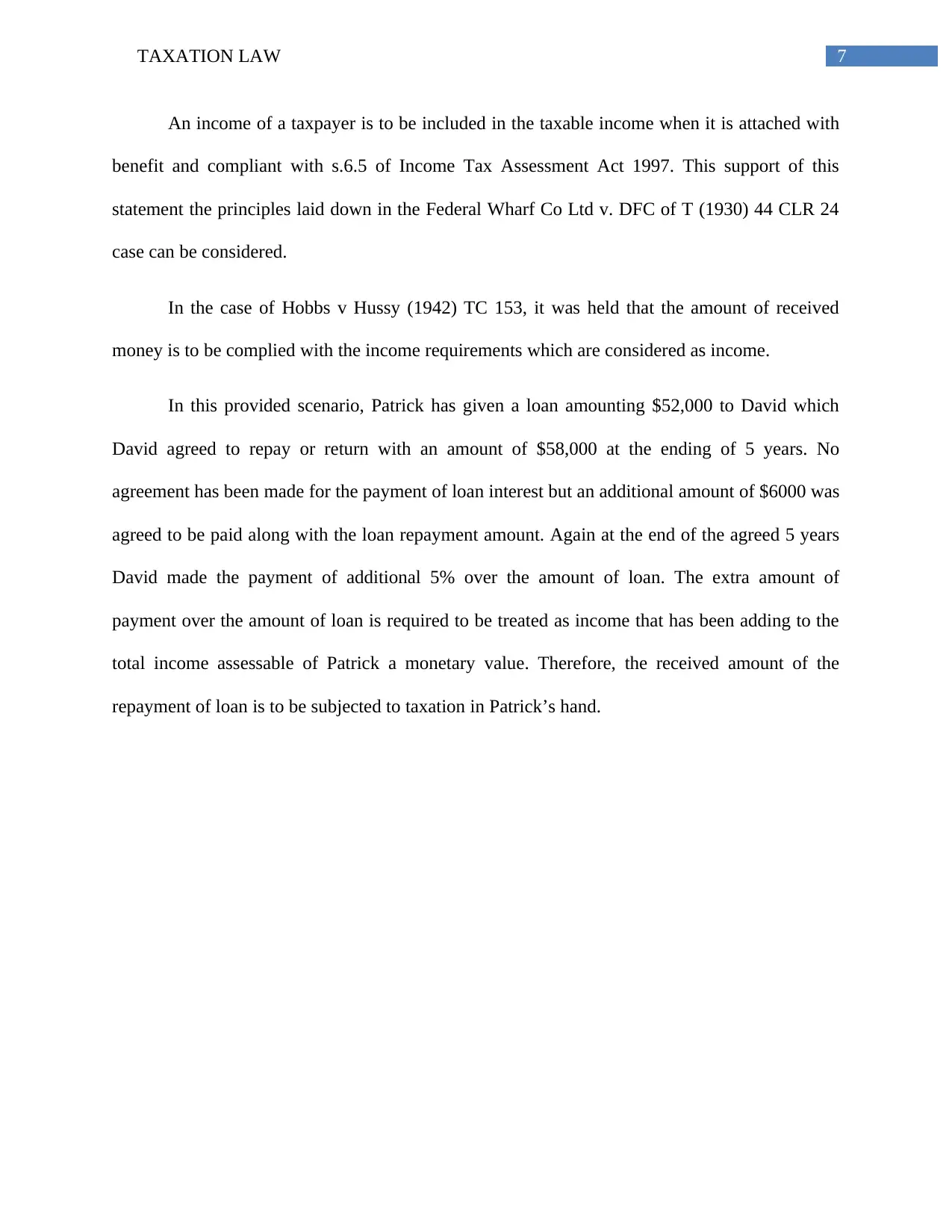
7TAXATION LAW
An income of a taxpayer is to be included in the taxable income when it is attached with
benefit and compliant with s.6.5 of Income Tax Assessment Act 1997. This support of this
statement the principles laid down in the Federal Wharf Co Ltd v. DFC of T (1930) 44 CLR 24
case can be considered.
In the case of Hobbs v Hussy (1942) TC 153, it was held that the amount of received
money is to be complied with the income requirements which are considered as income.
In this provided scenario, Patrick has given a loan amounting $52,000 to David which
David agreed to repay or return with an amount of $58,000 at the ending of 5 years. No
agreement has been made for the payment of loan interest but an additional amount of $6000 was
agreed to be paid along with the loan repayment amount. Again at the end of the agreed 5 years
David made the payment of additional 5% over the amount of loan. The extra amount of
payment over the amount of loan is required to be treated as income that has been adding to the
total income assessable of Patrick a monetary value. Therefore, the received amount of the
repayment of loan is to be subjected to taxation in Patrick’s hand.
An income of a taxpayer is to be included in the taxable income when it is attached with
benefit and compliant with s.6.5 of Income Tax Assessment Act 1997. This support of this
statement the principles laid down in the Federal Wharf Co Ltd v. DFC of T (1930) 44 CLR 24
case can be considered.
In the case of Hobbs v Hussy (1942) TC 153, it was held that the amount of received
money is to be complied with the income requirements which are considered as income.
In this provided scenario, Patrick has given a loan amounting $52,000 to David which
David agreed to repay or return with an amount of $58,000 at the ending of 5 years. No
agreement has been made for the payment of loan interest but an additional amount of $6000 was
agreed to be paid along with the loan repayment amount. Again at the end of the agreed 5 years
David made the payment of additional 5% over the amount of loan. The extra amount of
payment over the amount of loan is required to be treated as income that has been adding to the
total income assessable of Patrick a monetary value. Therefore, the received amount of the
repayment of loan is to be subjected to taxation in Patrick’s hand.
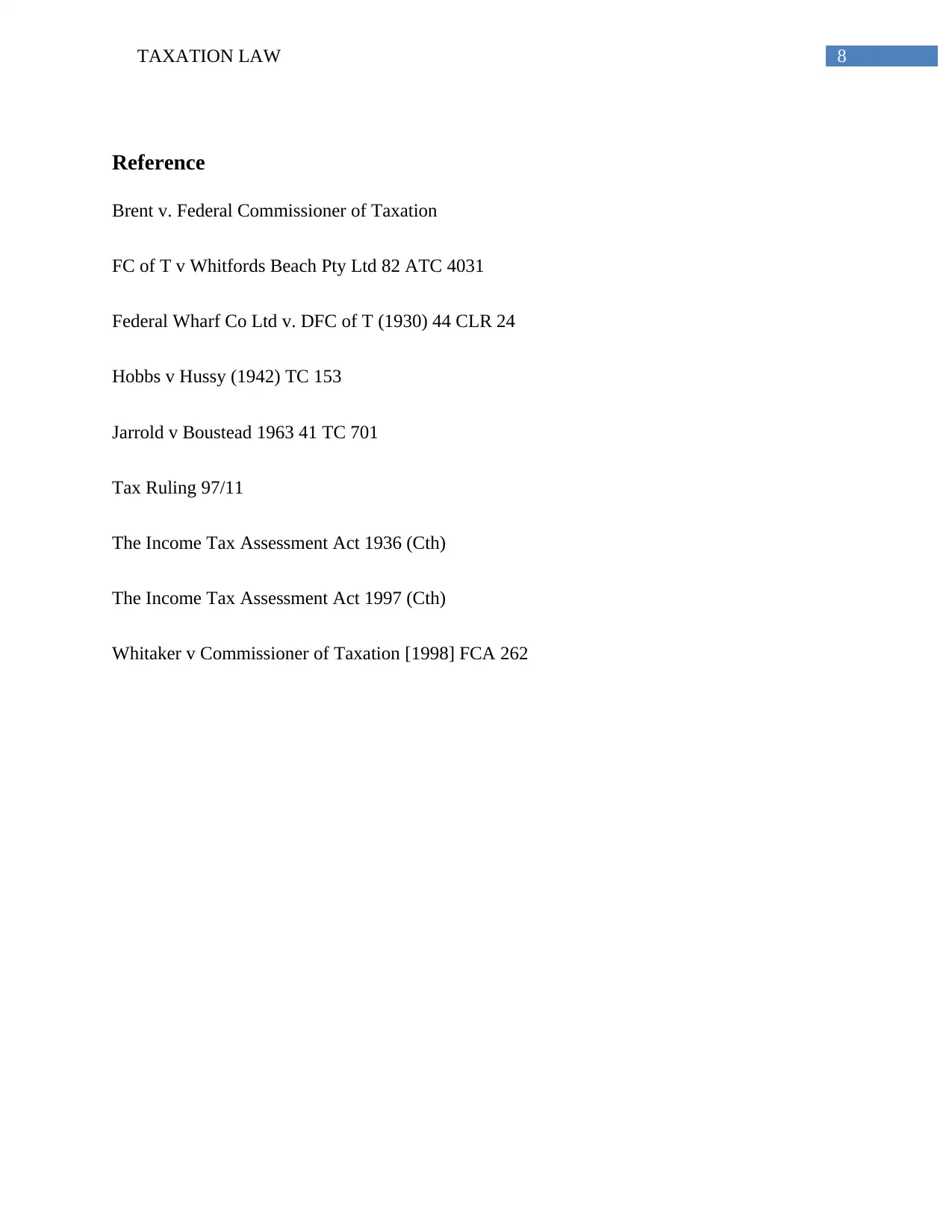
8TAXATION LAW
Reference
Brent v. Federal Commissioner of Taxation
FC of T v Whitfords Beach Pty Ltd 82 ATC 4031
Federal Wharf Co Ltd v. DFC of T (1930) 44 CLR 24
Hobbs v Hussy (1942) TC 153
Jarrold v Boustead 1963 41 TC 701
Tax Ruling 97/11
The Income Tax Assessment Act 1936 (Cth)
The Income Tax Assessment Act 1997 (Cth)
Whitaker v Commissioner of Taxation [1998] FCA 262
Reference
Brent v. Federal Commissioner of Taxation
FC of T v Whitfords Beach Pty Ltd 82 ATC 4031
Federal Wharf Co Ltd v. DFC of T (1930) 44 CLR 24
Hobbs v Hussy (1942) TC 153
Jarrold v Boustead 1963 41 TC 701
Tax Ruling 97/11
The Income Tax Assessment Act 1936 (Cth)
The Income Tax Assessment Act 1997 (Cth)
Whitaker v Commissioner of Taxation [1998] FCA 262
⊘ This is a preview!⊘
Do you want full access?
Subscribe today to unlock all pages.

Trusted by 1+ million students worldwide
1 out of 9
Related Documents
Your All-in-One AI-Powered Toolkit for Academic Success.
+13062052269
info@desklib.com
Available 24*7 on WhatsApp / Email
![[object Object]](/_next/static/media/star-bottom.7253800d.svg)
Unlock your academic potential
Copyright © 2020–2025 A2Z Services. All Rights Reserved. Developed and managed by ZUCOL.





